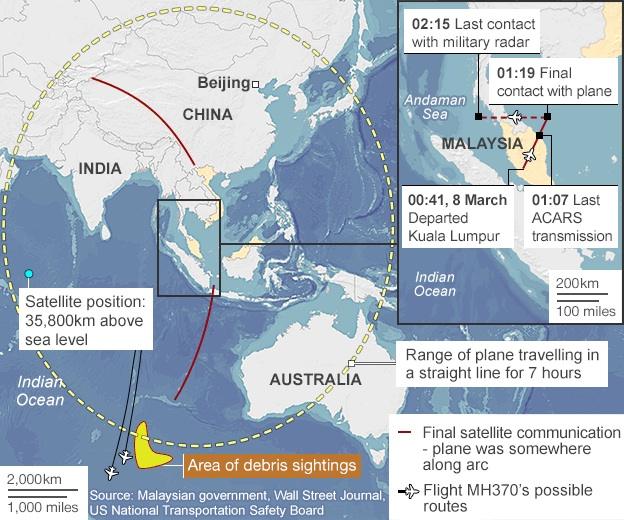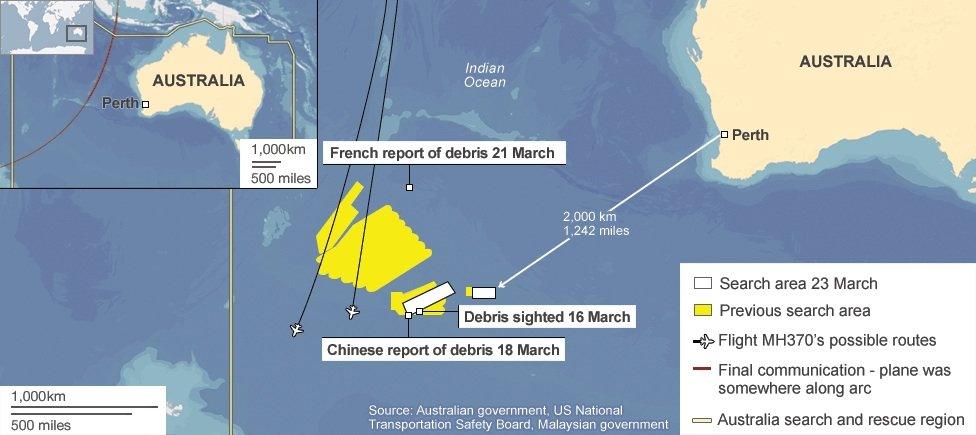Malaysia flight MH370: China spots 'suspicious' objects
- Published

Japan has joined China, Australia, New Zealand and the US in the southern Indian Ocean search
A Chinese plane hunting for the missing Malaysia Airlines plane has spotted "suspicious" objects, state media say, as more nations joined the search.
Searchers saw two "relatively big" objects with "many white smaller ones scattered within a radius of several kilometres", Xinhua news agency said.
Meanwhile, Australia says its aircraft found two objects, one circular and one rectangular, in its search area.
Flight MH370 disappeared on 8 March with 239 people on board.
Ten planes were scheduled to scour the southern Indian Ocean area on Monday for possible debris picked up earlier by radar echoes and satellite imagery.
Two Chinese military planes flew out to the search area, around 2,500 km (1,550 miles) south-west of Australian city Perth, on Monday morning, while two Japanese P-3 Orion aircraft set off later in the day.

They joined six other planes, including US and Australian military planes, in searching a 68,500 sq km (26,000 sq miles) area in the ocean.
An Australian navy ship is already in the area, while several Chinese ships are also on their way.
Bad weather
"When two of our IL-76 planes were searching the relevant suspected sea area, one of the planes photographed white, square floating objects," Chinese foreign ministry spokesman Hong Lei told reporters at a regular press briefing.
"At present we are unable to confirm whether the floating objects are related to the missing passenger jet," he said, adding that China was currently analysing the photographs.
The IL-76 crew has given co-ordinates of the objects to the Australian Maritime Safety Authority (Amsa), as well as China's ice-breaker Xue Long, which is heading to the area, Xinhua news agency says.
In a statement, Amsa, which is co-ordinating search efforts, said it "was advised about the reported objects sighted by a Chinese aircraft.
"The reported objects are within today's search area and attempts will be made to relocate them."
However, the US Navy P8 Poseidon plane tasked with investigating the reported sightings was unable to relocate the objects, Amsa said later on its Twitter feed, external.
Earlier, the authority had warned that weather conditions in the search area were expected to deteriorate.
Jennifer Pak reports from Kuala Lumpur on a cycling show of support for families and friends of those on board the missing plane
Warren Truss, Australia's acting prime minister while Tony Abbott is abroad, said that a tropical cyclone north of the search area could "stir up less favourable weather" for the search.
The search for flight MH370 has been in two large corridors - one stretching to the north-west of the last known location in the Malacca Straits and one to the south-west.
However, none of the countries on the northern corridor have reported any radar contact, and the Australian and Chinese satellite images of possible debris in the south Indian Ocean have concentrated the search there.
On Sunday, French officials said radar echoes from a satellite also identified possible debris in the south Indian Ocean.
The objects identified by the French satellite were "about 850 km north of our current search area", Mr Truss told Australian broadcaster ABC, external.
"That's not in the area that had been identified as the most likely place where the aircraft may have entered the sea. But having said all that we've got to check out all the options."
On Monday, the US Pacific Command said it was moving a black box locator to the region "as a precautionary measure in case a debris field is located".
The equipment, which has a "highly sensitive listening capability", detects pings from the black box while being towed behind a ship.
The move did not indicate that debris had been found, the US added, but would enable search officers to "respond as quickly as possible" if debris is seen, "since the battery life of the black box's pinger is limited".
"The search has taken us halfway around the world," Malaysia's acting Transport Minister Hishammuddin Hussein said at a press briefing on Monday.
"At the moment there are new leads but nothing conclusive."
Police had interviewed more than 100 people, including families of both the pilot and co-pilot, he added.
